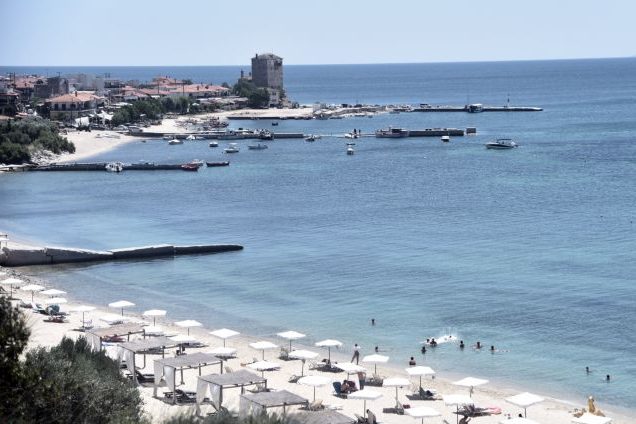Is it a product of the local perceptions that see “our” village as the most beautiful in the world or just another anecdotal buzzword among those that circulate from time to time jocularly at parties? Anyway, “there’s no place like Halkidiki”, even through its exaggeration, speaks a great truth. That, quite simply, there’s no place like Halkidiki! I also state that I do not hail from Northern Greece so that it causes me to discriminate blindly, but there is no place like Halkidiki. I found out by taking a long drive along all three “fingers” of the Kassandra Peninsula, the Sithonia Peninsula and the Mount Athos Peninsula, starting from Nea Moudania and Kassandria and ending at Ouranoupoli, the “gateway” to Mount Athos.
So what makes this area so special? Quite simply, the beauty of the landscape and the high quality of its beaches. The nature of Halkidiki, this verdant natural setting with the pine forests reaching down to the sea, is the invaluable treasure of the area. It is the reason why it has developed into one of the top tourist destinations of Greece. I have visited places with more historical sights and more dramatic landscapes. I have visited places where uncontrolled construction has not altered the environment so much, has not caused the disasters we observe, especially in the first finger – I have read complaints and investigations that talk about the encroachment and clearing of thousands of acres of forest. However, even where people acted abusively, the nature of Halkidiki worked healingly: Hiding as much as possible any ugliness behind its dense green imposing beauty!
Cassandra
A favorite vacation spot for residents of Thessaloniki, the first finger, the Kassandra Peninsula, is, as we have already said, the busiest. But it remains a place of remarkable natural beauty, as visitors easily discover by taking a tour and stopping at the most beautiful beaches. Our route, after crossing the Potidea canal, the canal that makes the peninsula look like an island, started from Sani. This is one of the most cosmopolitan corners of Northern Greece, since the luxurious “Sani Resort” with its five hotels (and its famous summer festival) operates there. The unique facilities for a Greek hotel with the seaside bungalows, the white sand beaches, the manicured gardens, the swimming pools, the tennis courts (and many more sports), the marina with the luxury shops, the award-winning restaurants and the moored boats is in itself an attraction. However, the biggest attraction of this area is nature: the olive groves, the fields with the crops, the pine forest on the sand dunes and the Stavronikita and Gerani lakes with their rich fauna. A protected area of the European Natura Network, Sani offers the visitor images of beauty and inspiration. Opposite it, Mount Olympus, huge and imposing, adds dramatic touches to the calm landscape and makes it even more impressive. Continuing to the south, we passed Siviri (in the amphitheater of which the Kassandra Festival is hosted), Skala Fourkas and Poseidi with its special beach, a narrow sandy strip of land that enters the sea. There is also a lighthouse about 15 meters high that was built in 1864. Continuing along the coast, we passed by Nea Skioni and continued stopping again and again at the magnificent beaches: Glarokavos, Pefkochori, Polychrono, Kriopigi, Afitos, Nea Fokea …
By the way, Afitos with its old stone houses with the founding inscriptions is of particular interest and is, in my opinion, the most beautiful village of the first finger.
Sithonia
As for the most picturesque village of the second finger, of the Sithonia Peninsula, this is, I believe, Nikiti. To be precise, the old Nikiti, which is built on a hill. Many of its old houses still stand, some of which are extremely well maintained. The characteristic chimneys of the houses, the like of which I do not remember ever seeing, are considered a trademark of the village. Its beach is also very beautiful, although, as we speak, there is no point in the second finger that does not invite you to dive in the waters. So, continuing on the road that makes the circle of Sithonia and following a magnificent pine-covered route, we passed Kalogria, Spathies, Elia, Lagomandra, Tripotamos, Tristinika, Toroni and we stopped for a while in Porto Koufo: The small fishing village is built at the bottom of an impressive natural harbor that is considered one of the safest in Greece. We breathed plenty of iodine, waived our hand at a fishing boat that was leaving port and continued to pass other beaches: from Kalamitsi, Kriaritsi, Sykia… Then I saw, for the first time, Mount Athos (where the end of the opposite third finger lies). Its mass (I did not realize that it is so tall) and its biblical grandeur left me speechless. Going north, we passed (what else?) even more wonderful beaches with thick sand, such as Sarti beach and Platanitsi. The Crab Holes are one of the most famous due to their exotic beauty: These are small coves with small sandy beaches and crystal clear turquoise waters. Another confirmation that… there’s no place like Halkidiki!
To Mount Athos
We continued along the coast looking far (it had wonderful visibility that day) to the shoreline of the third finger, with some of the monasteries faintly visible. Some small lightning flashes that we observed I guess came from the play of the sun among the domes of the churches. The landscape remained extremely beautiful. At some point we turned our backs on the sea and took the road to Ierissos. The smell of blooming, yellowish saplings came in through the open window of the car and stunned us with its sweetness. From there we headed to Ouranoupolis, passing through the narrow sea passage that separates Ammouliani, the only inhabited island of Halkidiki, from the peninsula. We arrived at the city which is also called the “threshold of Mount Athos”.
We parked at the port while a boat was disembarking a group of monks. Two other monks were drinking their coffee in front of the sea. The Tower of Ouranoupolis dominated the settlement and was more impressive than it appeared in the photos we had seen. I read that it is first mentioned in documents of 1344, but it is believed to be older. At some point after 1922, it was inhabited by refugees from Propontis and later by Scotsman Sidney Locke and his Australian wife Joyce, both journalists and writers. The couple came to Halkidiki from Thessaloniki where they lived providing services to refugees. In 1928 they settled permanently in Ouranoupolis due to Locke’s interest in the Athonite monasteries. He made the Tower of Ouranopolis his home and continued to help the refugees and the local community that lived in misery. Among other things, Locke taught these poor people to make and sell carpets with Greek themed motifs.
Even today in Pyrgos, which also functions as a museum, the personal belongings of these two people are hosted, who in such a moving way connected their history with that of the place. We photographed again and again the extremely photogenic Tower from every side, both from the side of the settlement and from the side of the beach, and we started the journey back to Thessaloniki. We had to leave (how to catch up with everything?) The mountainous Halkidiki we left for next time, but we made one last stop in the capital of the prefecture, Polygyros. That was a surprise though! We were impressed by the dozens of old houses. Unfortunately, most of them are collapsing or have already collapsed. What a pity! But it is a city worth devoting time to. We will be back, I hope. Again and again. Halkidiki has a lot more to give us.



